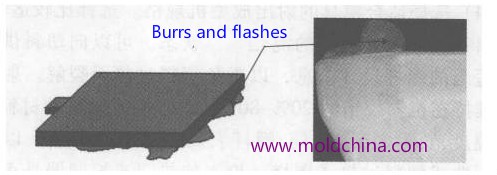Burrs and flashes mostly occur on contact surfaces – when the melt flows through the space between the core and the cavity, the sliding part of the slider, as well as the clearance of the insert and the ejector pin, etc., excessive flashing or burrs are formed on the molded product. Such flashing or burrs act as leverage during the plastic injection molding process to further increase the flashing or burrs, which leads to local depression on the mold, causing flashing or burrs to enter a vicious circle. Therefore, if flashing or burrs are found in the very beginning, the mold must be modified at the earliest possible time.

The several causes and solutions for burrs and flashes are shown below:
1. The fluidity of the plastic material is too good. Theoretically, that the fluidity of the plastic is too good is not the reason for the burr to occur. However, if the fluidity of the plastic is too good, even an extremely tiny gap can be penetrated by the molten material, so burrs are prone to appear in such circumstances. In order to eliminate burrs thus caused, you can either lower the melt temperature or the injection pressure, or reduce the mold temperature or the injection speed.
2. Excessive molten material is filled, which is not a direct cause of burrs. The method of injecting too much melt to prevent shrinkage is wrong, but the injection time or the holding time should be increased to mold the product.
3. Foreign substances on the mold surface. Foreign substances on the mold parting surface inevitably produce burrs. To solve the problem, it is clearly very necessary to clean the mold surface, so that the parting surface is tightly sealed.
4. Mold deflection. If the thickness of a mold is insufficient, it will be deflected by the injection pressure. At this moment, if there is a hole near the center, burrs will be generated around the hole; and if a central hole is used to create the side gate, burrs are also prone to occur around the hole and the runner. In this case, the burrs are caused by poor mold making, so it is difficult to resolve, since the burrs can only be reduced by improving the mold.
5. Insufficient clamping force. Relative to the projected area of the molded product, if the clamping force is weak, there will be gaps between the mold core and the mold cavity under the effect of the injection pressure, which will inevitably cause flashing or burrs. Especially, when the side gate is designed on the hole near the center of the product, burrs easily occur since this type of molding gate requires a very high injection pressure. Reducing the injection pressure or increasing the clamping force are able to eliminate this defect. It sometimes can be effective if you switch to plastics with good fluidity and adopt low-pressure molding based on the specific situation.
6. Local part of the mold is not tightly matched, which is often caused by poor mold parallelism or poor adjustment of the mold clamping unit, such as imbalanced mold clamping on the left and right sides, i.e., only one side is tightly locked, while the other is not. At this point of time, the tie rods (two or four tie rods) must be adjusted to make them evenly spread. Then, there are also molds with poorly matched parts due to improper development. The insert gaps and ejector pinholes will malignantly increase not only the burrs, but also the ejection resistance.
7. Unreasonable gate size of multi-cavity molds, leading to uneven filling.
Solution: Rationalize the gate size according to product structure and runner length.
8. The mold temperature is too high, leading to excessively high hot runner temperature.
Solution: Adjust the mold temperature. Check the settings of the heater, the thermocouple and the temperature controller of the hot runner mold, and reduce the temperature of the hot runner.
9. The injection pressure is too high, injection speed too fast, holding pressure too high, and holding time too long.
Solution: Adjust the injection pressure, lower the injection speed, reduce the holding pressure, and shorten the holding time.
